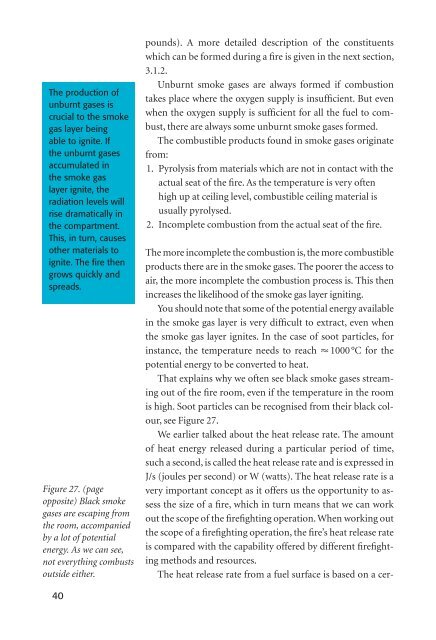You also want an ePaper? Increase the reach of your titles
YUMPU automatically turns print PDFs into web optimized ePapers that Google loves.
The production of<br />
unburnt gases is<br />
crucial to the smoke<br />
gas layer being<br />
able to ignite. If<br />
the unburnt gases<br />
accumulated in<br />
the smoke gas<br />
layer ignite, the<br />
radiation levels will<br />
rise dramatically in<br />
the compartment.<br />
This, in turn, causes<br />
other materials to<br />
ignite. The fi re then<br />
grows quickly and<br />
spreads.<br />
Figure 27. (page<br />
opposite) Black smoke<br />
gases are escaping from<br />
the room, accompanied<br />
by a lot of potential<br />
energy. As we can see,<br />
not everything combusts<br />
outside either.<br />
40<br />
pounds). A more detailed description of the constituents<br />
which can be formed during a fi re is given in the next section,<br />
3.1.2.<br />
Unburnt smoke gases are always formed if combustion<br />
takes place where the oxygen supply is insuffi cient. But even<br />
when the oxygen supply is suffi cient for all the fuel to combust,<br />
there are always some unburnt smoke gases formed.<br />
The combustible products found in smoke gases originate<br />
from:<br />
1. Pyrolysis from materials which are not in contact with the<br />
actual seat of the fi re. As the temperature is very often<br />
high up at ceiling level, combustible ceiling material is<br />
usually pyrolysed.<br />
2. Incomplete combustion from the actual seat of the fi re.<br />
The more incomplete the combustion is, the more combustible<br />
products there are in the smoke gases. The poorer the access to<br />
air, the more incomplete the combustion process is. This then<br />
increases the likelihood of the smoke gas layer igniting.<br />
You should note that some of the potential energy available<br />
in the smoke gas layer is very diffi cult to extract, even when<br />
the smoke gas layer ignites. In the case of soot particles, for<br />
instance, the temperature needs to reach u 1000 °C for the<br />
potential energy to be converted to heat.<br />
That explains why we often see black smoke gases streaming<br />
out of the fi re room, even if the temperature in the room<br />
is high. Soot particles can be recognised from their black colour,<br />
see Figure 27.<br />
We earlier talked about the heat release rate. The amount<br />
of heat energy released during a particular period of time,<br />
such a second, is called the heat release rate and is expressed in<br />
J/s (joules per second) or W (watts). The heat release rate is a<br />
very important concept as it offers us the opportunity to assess<br />
the size of a fi re, which in turn means that we can work<br />
out the scope of the fi refi ghting operation. When working out<br />
the scope of a fi refi ghting operation, the fi re’s heat release rate<br />
is compared with the capability offered by different fi refi ghting<br />
methods and resources.<br />
The heat release rate from a fuel surface is based on a cer-

















